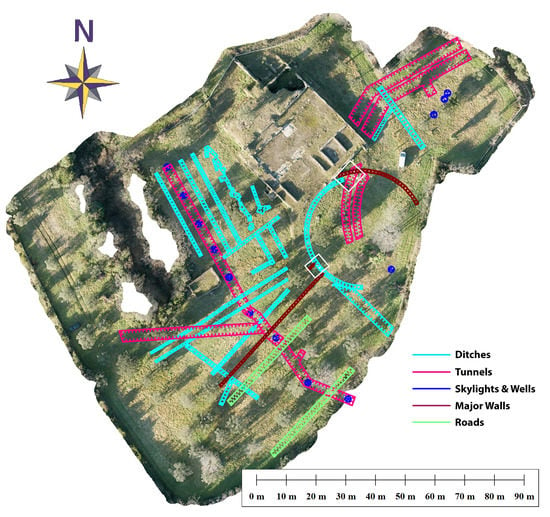Reconstruction of a Segment of the UNESCO World Heritage Hadrian’s Villa Tunnel Network by Integrated GPR, Magnetic–Paleomagnetic, and Electric Resistivity Prospections
Abstract
1. Introduction
1.1. Archaeological Background
1.2. Geological Setting
1.3. Previous Geophysical Investigations at Hadrian’s Villa
1.4. Integration of Geophysical Datasets
1.5. Rationale for Magnetic Field Modelling in the Plutonium-Inferi Area
2. Methods
2.1. GPR Data Acquisition Procedures
- Survey mode = Distance mode (with odometer);
- Scans/m = 50;
- Samples/scan = 1024;
- Range = 300 ns;
- Bits/sample = 32;
- Line spacing = 0.5 m;
- Antenna = GSSI 5106, 200 MHz, shielded antenna
2.2. GPR Data Processing
- Automatic gain control;
- Time-zero correction;
- Band pass filtering (~100–300 MHz);
- Background removal;
- Kirchhoff migration;
- Creation of amplitude slices;
- Normalization;
- Equalization; and
- Knitting
2.3. Magnetic Field Intensity Acquisition
2.4. Magnetic Field Processing
2.5. Paleomagnetic Acquisition & Processing
2.6. Electric Resistivity Acquisition & Processing
2.7. Aerial Photogrammetry
3. Results
3.1. GPR Amplitude Slices
3.2. Magnetic Anomalies
3.3. Paleomagnetic Analysis
3.4. Electric Resistivity Survey
4. Discussion
“Tiburtinam villam mire aedificavit, ita ut in ea et provinciarum et locorum celeberrima nomina inscriberet, velut Lycium, Academian, Prytanium, Canopum, Poecilen, Tempe vocaret. Et, ut nihil praetermitteret, etiam inferos finxit.”.(from Historia Augusta, 26, 5)
“His villa at Tibur was marvelously constructed, and he actually gave to parts of it the names of provinces and places of the greatest renown, calling them, for instance, Lyceum, Academia, Prytaneum, Canopus, Poecile, and Tempe. And in order not to omit anything, he even made a Hades.”
5. Conclusions
Supplementary Materials
Author Contributions
Funding
Acknowledgments
Conflicts of Interest
References and Notes
- Salza Prina Ricotti, E. Criptoportici e Gallerie sotterranee di Villa Adriana nella loro tipologia e nelle loro funzioni. Publications de l’École Française de Rome 1973, 14, 219–259. [Google Scholar]
- Ligorio, P. Codice Vaticano latino 5295, Trattato delle Antichità di Tivoli et della Villa Hadriana fatto da Pyrrho Ligorio Patritio 72 Napoletano et dedicato all’Ill.mo Cardinal di Ferrara; Biblioteca Apostolica Vaticana: Cortile del Belvedere, Italy, 5295 fol. 1r-32 v.
- Contini, F. Hadriani Caesaris Immanem in Agro Tiburtino Villam; per Fabio di Falco: Roma, Italy, 1668; tav. VIII. [Google Scholar]
- Penna, A. Viaggio Pittorico Della Villa Adriana Composto di Vedute Disegnate dal Vero ed Incise da Agostino Penna con una Breve Descrizione di Ciascun Monumento; della tipografia di Pietro Aureli: Roma, Italy, 1836. [Google Scholar]
- Colvin, H. Architecture and the After-Life; Yale University Press: London, UK, 1992. [Google Scholar]
- Funiciello, R.; Giordano, G.; De Rita, D. The Albano maar lake (Colli Albani Volcano, Italy): Recent volcanic activity and evidence of pre-Roman Age catastrophic lahar events. J. Volcanol. Geotherm. Res. 2003, 123, 43–61. [Google Scholar] [CrossRef]
- Giordano, G.; De Benedetti, A.A.; Diana, A.; Diano, G.; Gaudioso, F.; Marasco, F.; Miceli, M.; Mollo, S.; Cas, R.A.F.; Funiciello, R. The Colli Albani mafic caldera (Roma, Italy): Stratigraphy, structure and petrology. J. Volcanol. Geotherm. Res. 2006, 155, 49–80. [Google Scholar] [CrossRef]
- Soligo, M.; Tuccimei, P. Geochronology of Colli Albani volcano. In The Colli Albani Volcano; Funiciello, R., Giordano, G., Eds.; The Geological Society of London: London, UK, 2010; Special Publications of IAVCEI, 3; pp. 154–196. [Google Scholar]
- Vinkler, A.P.; Cashman, K.; Giordano, G.; Groppelli, G. Evolution of the mafic Villa Senni caldera-forming eruption at Colli Albani volcano, Italy, indicated by textural analysis of juvenile fragments. J. Volcanol. Geotherm. Res. 2012, 235–236, 37–54. [Google Scholar] [CrossRef]
- Watkins, S.D.; Giordano, G.; Cas, R.A.F.; De Rita, D. Emplacement processes of the mafic Villa Senni Eruption Unit (VSEU) ignimbrite succession, Colli Albani volcano, Italy. J. Volcanol. Geotherm. Res. 2002, 118, 173–203. [Google Scholar] [CrossRef]
- Porreca, M.; Mattei, M.; Giordano, G.; De Rita, D.; Funiciello, R. Magnetic fabric and implications for pyroclastic flow and lahar emplacement, Albano maar, Italy. J. Geophys. Res. 2003, 108, 2264. [Google Scholar] [CrossRef]
- Trolese, M.; Giordano, G.; Cifelli, F.; Winkler, A.; Mattei, M. Forced transport of thermal energy in magmatic and phreatomagmatic large volume ignimbrites: Paleomagnetic evidence from the Colli Albani volcano, Italy. Earth Planet. Sci. Lett. 2017, 478, 179–191. [Google Scholar] [CrossRef]
- Gaffney, C. Detecting trends in the prediction of the buried past: A review of geophysical techniques in archaeology. Archaeometry 2008, 50, 313–336. [Google Scholar] [CrossRef]
- De Franceschini, M.; Marras, A.M. New discoveries with geophysics in the Accademia of Hadrian’s Villa near Tivoli (Rome). Adv. Geosci. 2010, 24, 2. [Google Scholar] [CrossRef][Green Version]
- Hay, S. The Plutonium at Hadrian’s Villa: Geophysical Survey Report 2016, 1–29.
- Gorrini, M.E.; Melfi, M.; Montali, G.; Schettino, A. Il progetto Plutonium di Villa Adriana: Prime considerazioni a margine del nuovo rilievo e prospettive di ricerca. In Adventus Hadriani, G.E. Cinque ed., Convegno internazionale di studi, Roma-Tivoli 4–7 luglio 2018, in press.
- Verdiani, G. Cryptoporticus, La rete delle strade diventa sotterranea a Villa Adriana, Tivoli. Firenze Archit. 2017, 21, 162–169. [Google Scholar] [CrossRef]
- Placidi, M.; Fresi, V. Tivoli, Villa Adriana, Strada sotterranea cd “Strada Carrabile”, Campagna di studio 2007–2008, breve sintesi dei risultati. J. Fasti Online 2010, 190, 1–6. [Google Scholar]
- Van Leusen, M. Archaeological data integration. In Handbook of Archaeological Sciences; Brothwell, D.R., Pollard, A.M., Eds.; Wiley: New York, NY, USA, 2001; pp. 575–584. [Google Scholar]
- Küçükdemirci, M.; Özer, E.; Piro, S.; Baydemir, N.; Zamuner, D. An application of integration approaches for archaeo-geophysical data: Case study from Aizanoi. Archaeol. Prospect. 2018, 25, 33–44. [Google Scholar] [CrossRef]
- Kvamme, K.L. Integrating multiple geophysical datasets. In Remote Sensing in Archaeology; Wiseman, J., El-Baz, F., Eds.; Springer: New York, NY, USA, 2007; pp. 345–374. [Google Scholar]
- Piro, S.; Mauriello, P.; Cammarano, F. Quantitative integration of geophysical methods for archaeological prospection. Archaeol. Prospect. 2000, 7, 203–213. [Google Scholar] [CrossRef]
- Kvamme, K.L. Geophysical correlation: Global versus local perspectives. Archaeol. Prospect. 2018, 25, 111120. [Google Scholar] [CrossRef]
- Davis, J.C. Statistics and Data Analysis in Geology, 3rd ed.; John Wiley: New York, NY, USA, 2002; p. 638. [Google Scholar]
- Harris, J.R.; Viljoen, D.W.; Rencz, A.N. Integration and visualization of geoscience data. Remote Sensing for the Earth Sciences. In Manual of Remote Sensing, 3rd ed.; John Wiley & Sons, Inc.: Hoboken, NJ, USA, 1999; Volume 3, pp. 307–354. [Google Scholar]
- Schettino, A.; Ghezzi, A.; Pierantoni, P.P. Magnetic field modelling and analysis of uncertainty in archaeological geophysics. Archaeol. Prospect. 2019, 26, 137–153. [Google Scholar] [CrossRef]
- Ghezzi, A.; Schettino, A.; Tassi, L.; Pierantoni, P.P. Magnetic modelling and error assessment in archaeological geophysics: The case study of Urbs Salvia, central Italy. Ann. Geophys. 2018, 61. [Google Scholar] [CrossRef]
- Solheid, P.A. Mössbauer revisited. IRM Q. 1998, 8, 1–6. [Google Scholar]
- Furman, A.; Ferré, T.; Warrick, A.W. A sensitivity analysis of electrical resistivity tomography array types using analytical element modeling. Vadose Zone J. 2003, 2, 416–423. [Google Scholar] [CrossRef]
- Loke, M.H.; Barker, R.D. Least-squares deconvolution of apparent resistivity pseudosections. Geophysics 1995, 60, 1682–1690. [Google Scholar] [CrossRef]
- Conyers, L.B. Ground-Penetrating Radar and Magnetometry for Buried Landscape Analysis; Springer: Berlin/Heidelberg, Germany, 2018. [Google Scholar]
- Spector, A.; Grant, F.S. Statistical models for interpreting aeromagnetic data. Geophysics 1970, 35, 293–302. [Google Scholar] [CrossRef]
- Piranesi, G.B.; Piranesi, F. Pianta Delle Fabbriche Esistenti Nella Villa Adriana, Roma, Italy. 1781. Available online: https://www.europeana.eu/portal/it/record/9200232/BibliographicResource_3000004737529.html (accessed on 22 July 2019).
- Jashemski, W.F.; Salza Prina Ricotti, E. Preliminary excavations in the gardens of Hadrian’s Villa: The Canopus area and the Piazza d’Oro. Am. J. Archaeol. 1992, 96, 579–597. [Google Scholar] [CrossRef]
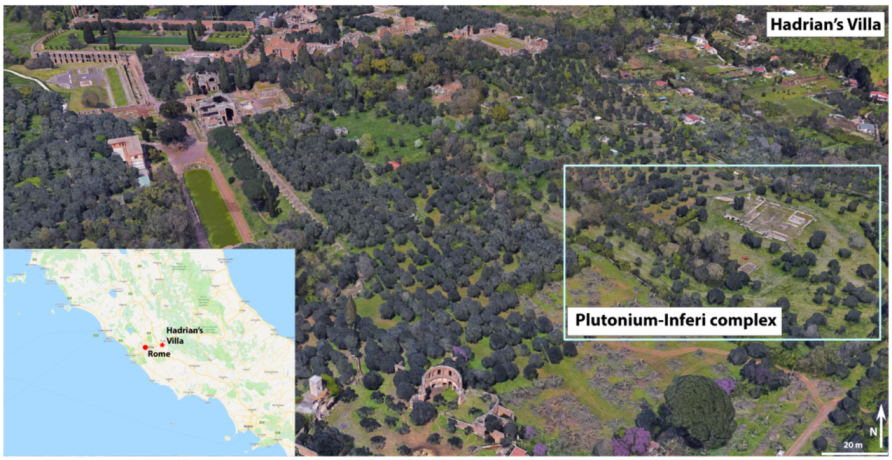
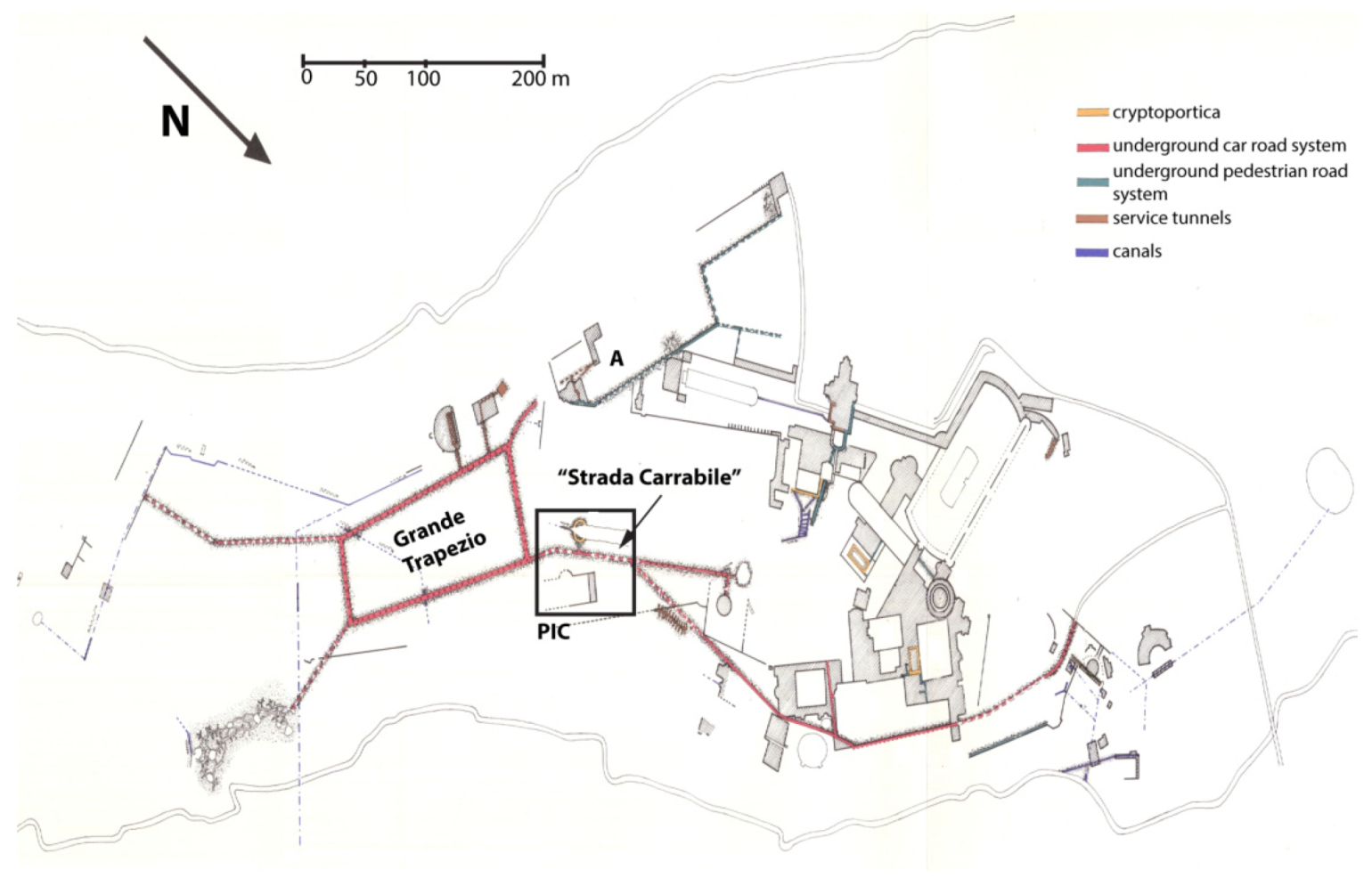
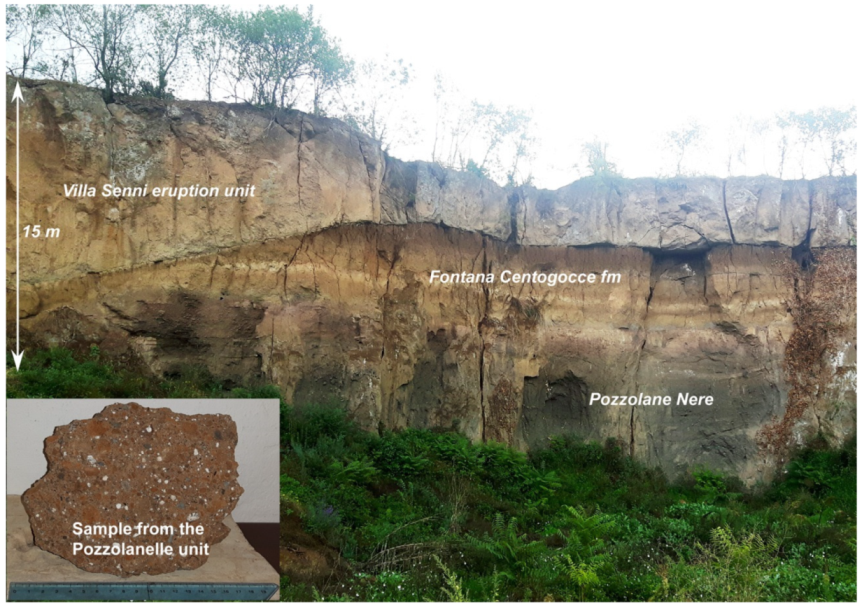
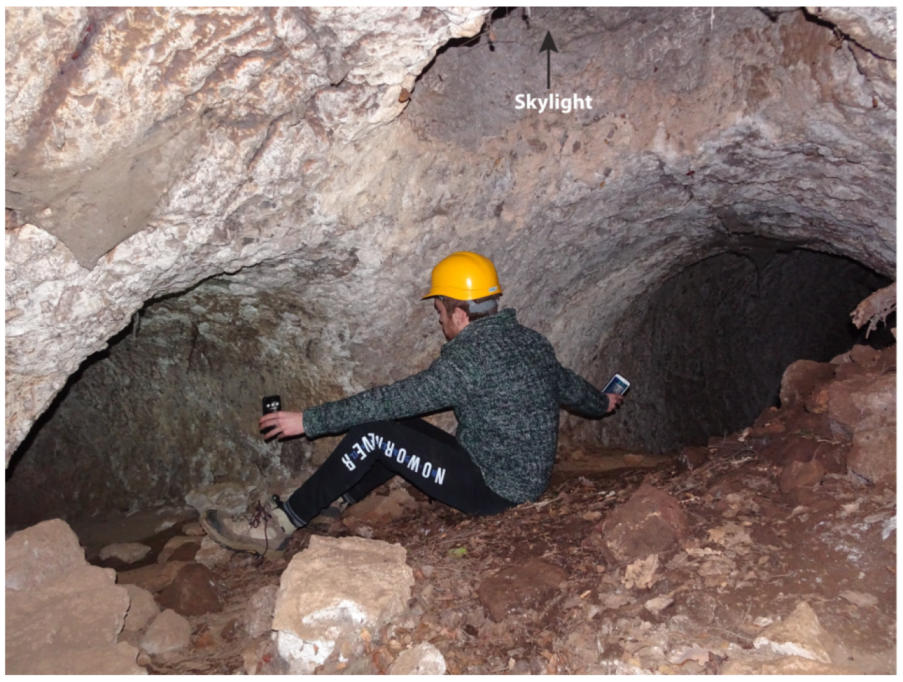
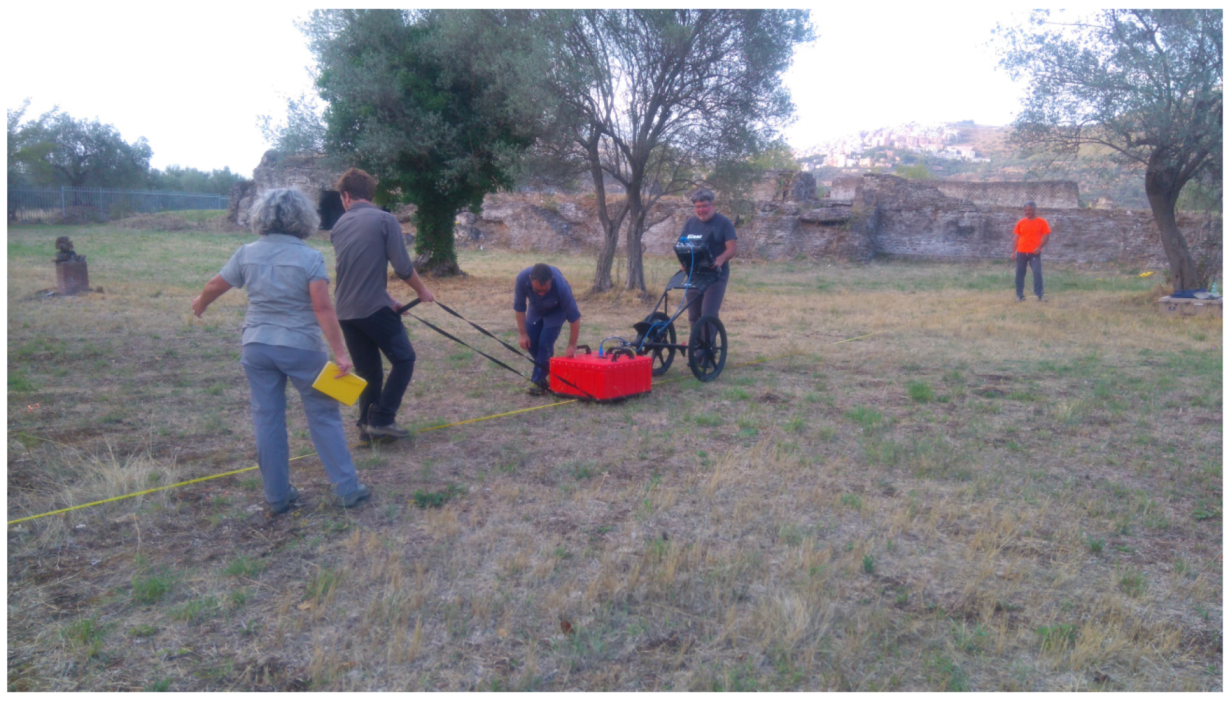
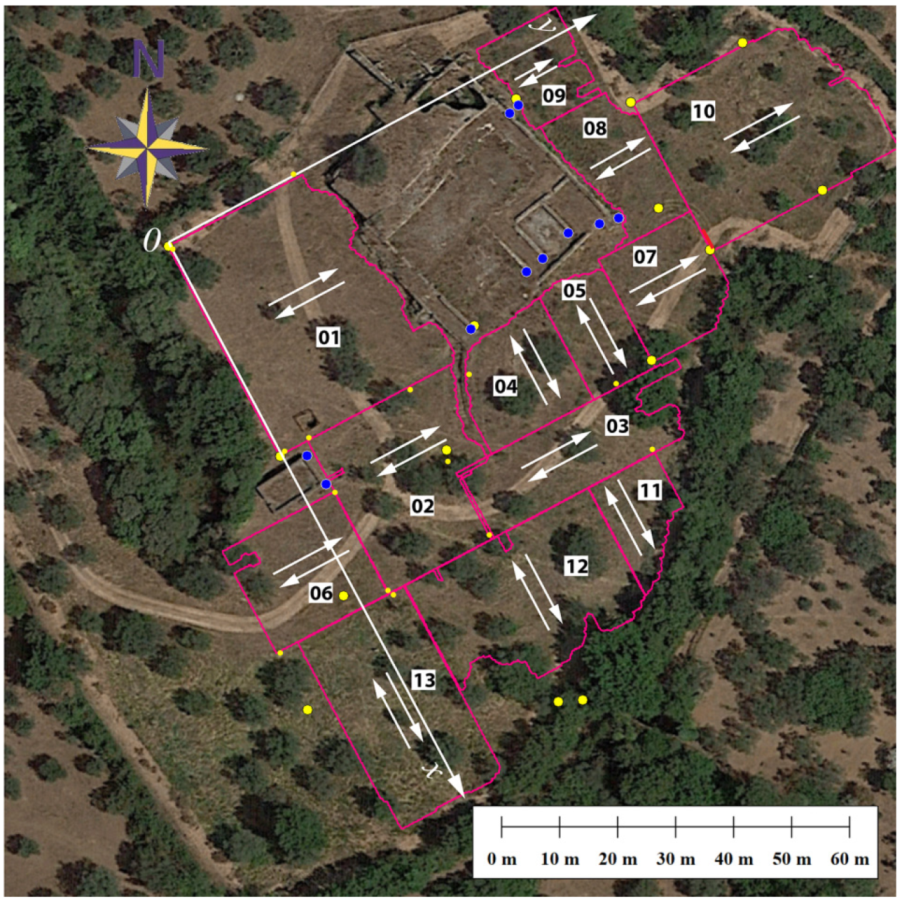
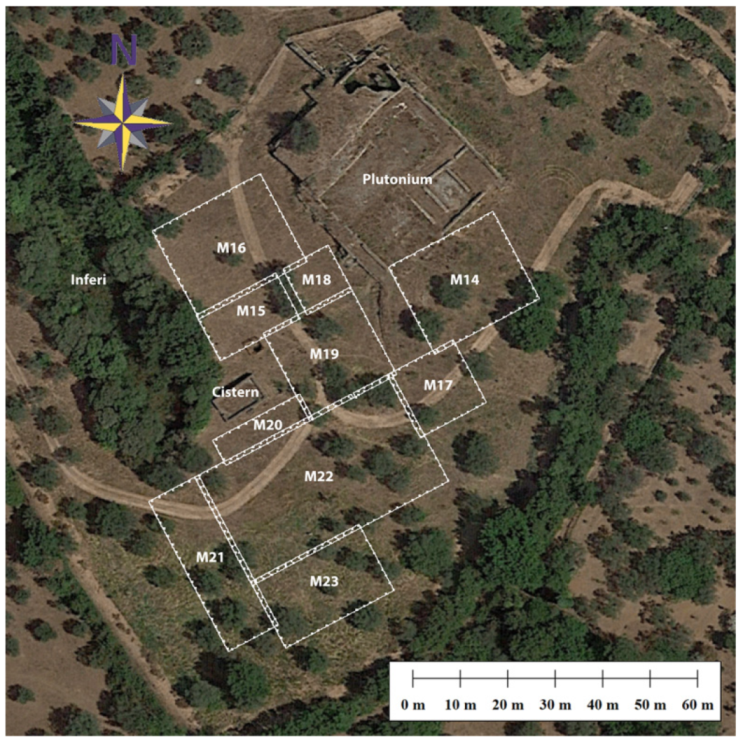
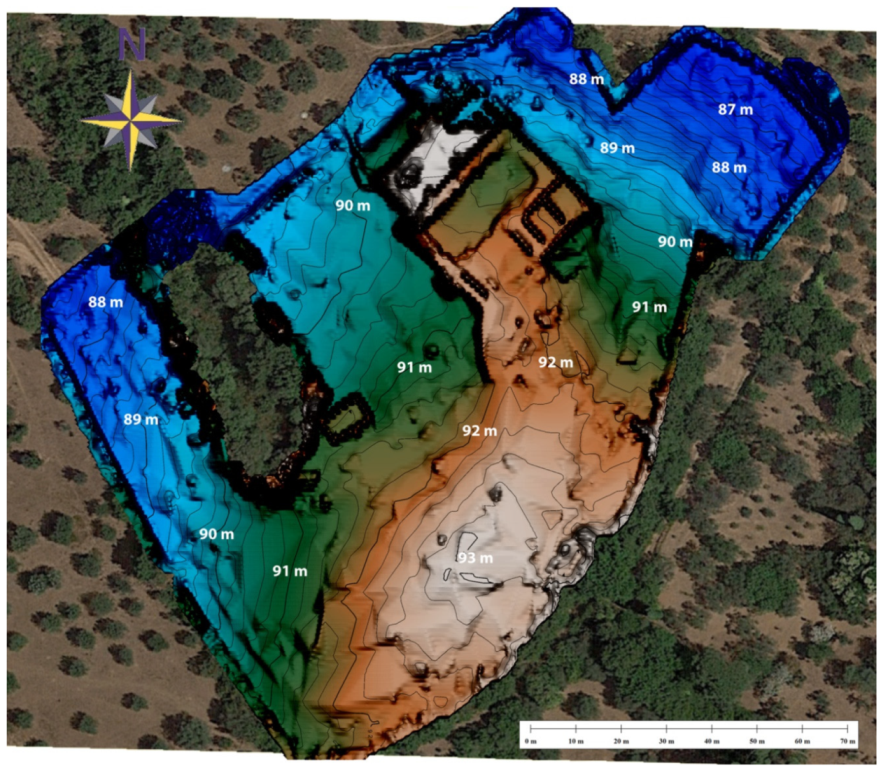
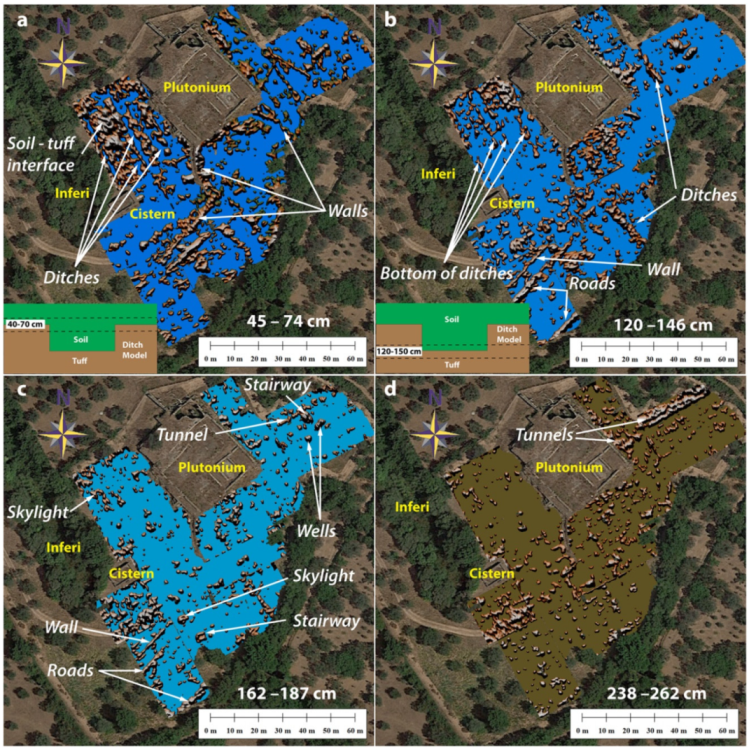
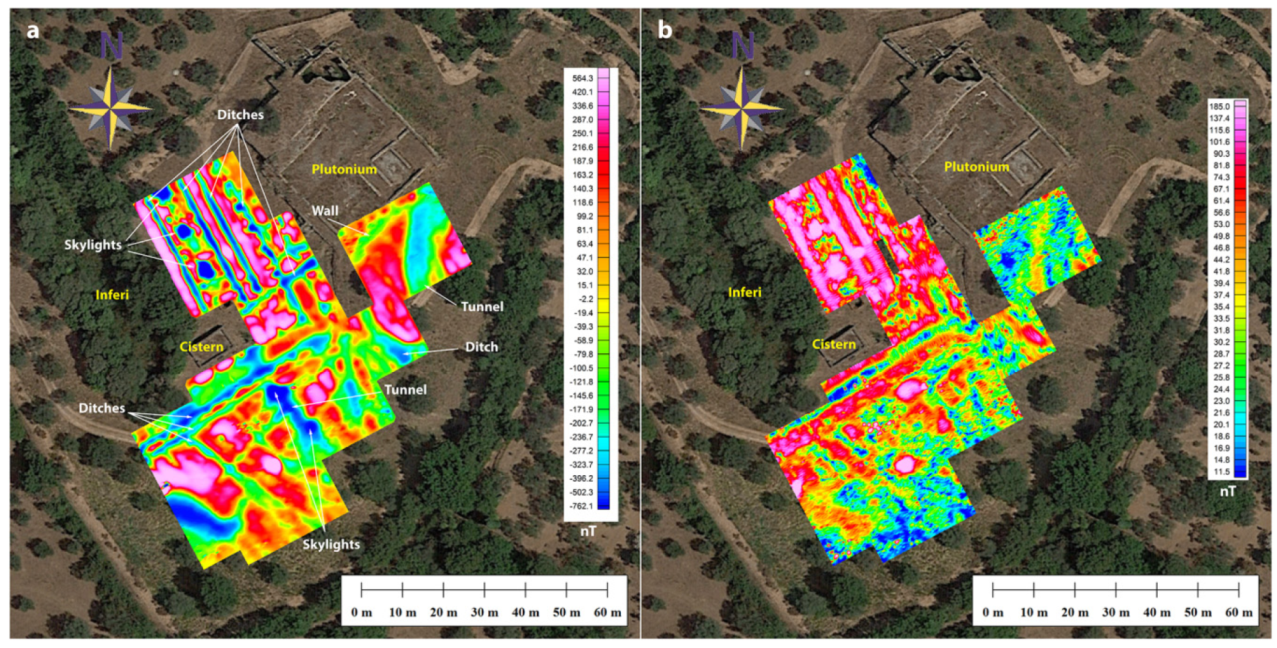
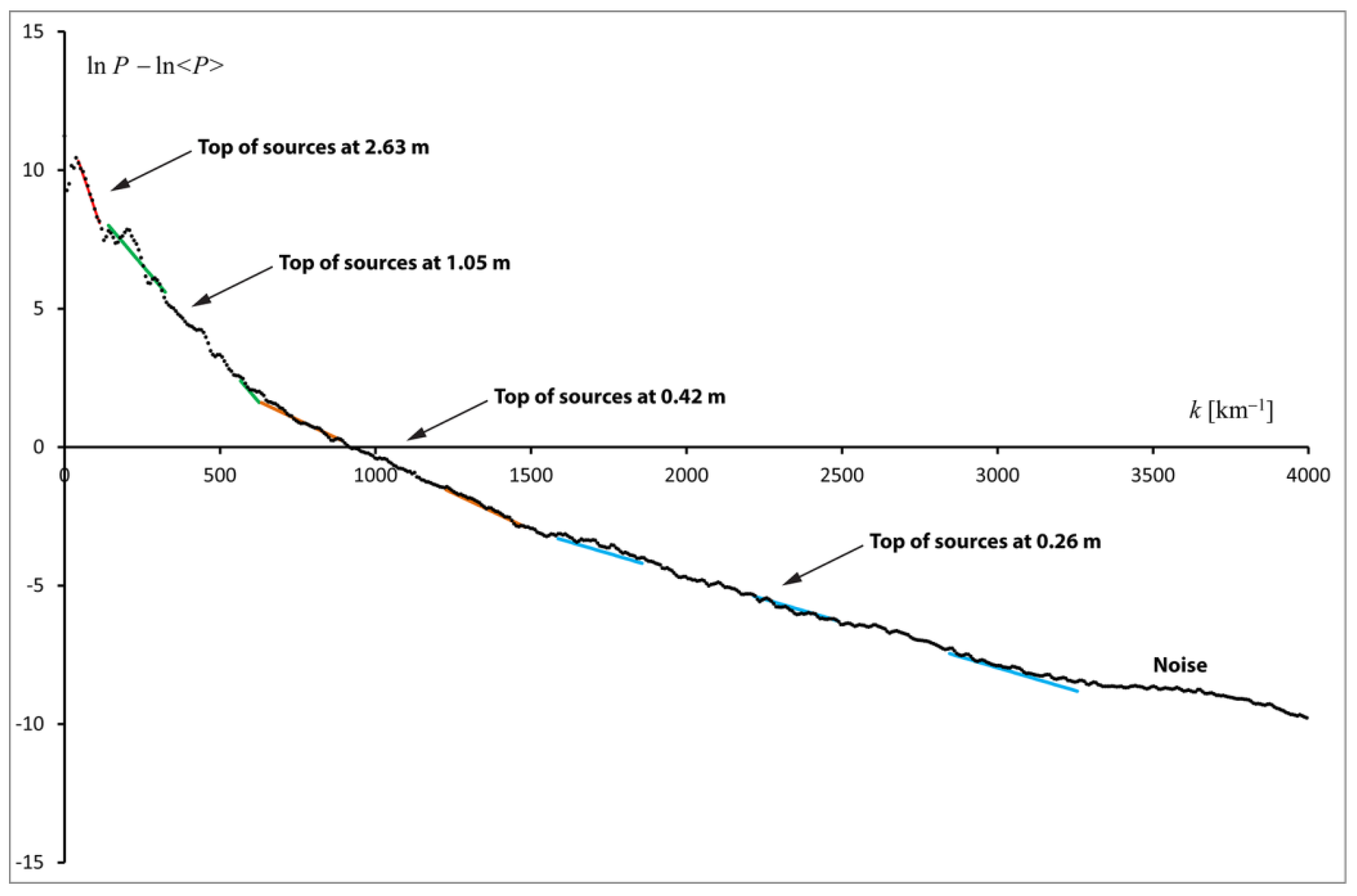
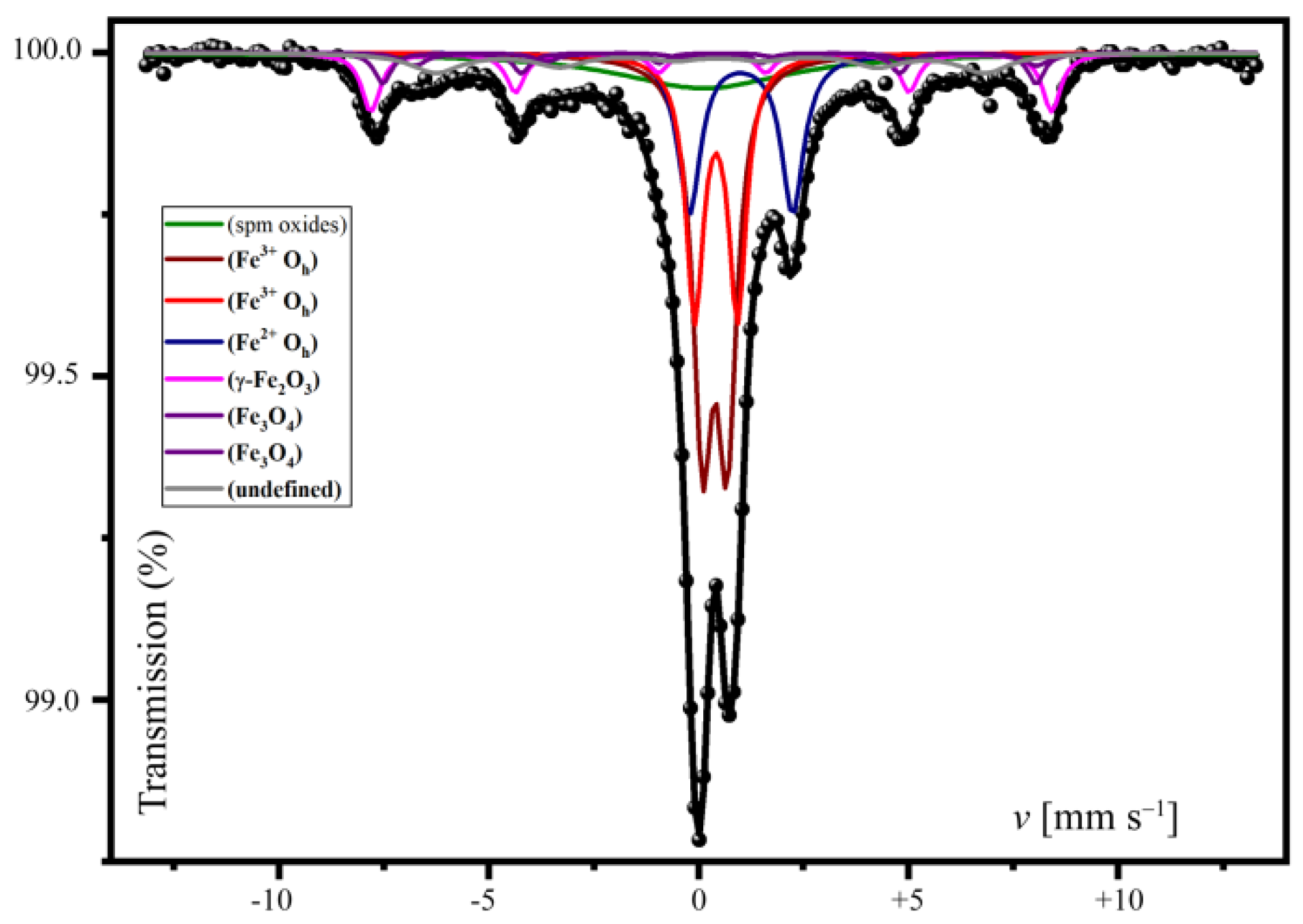
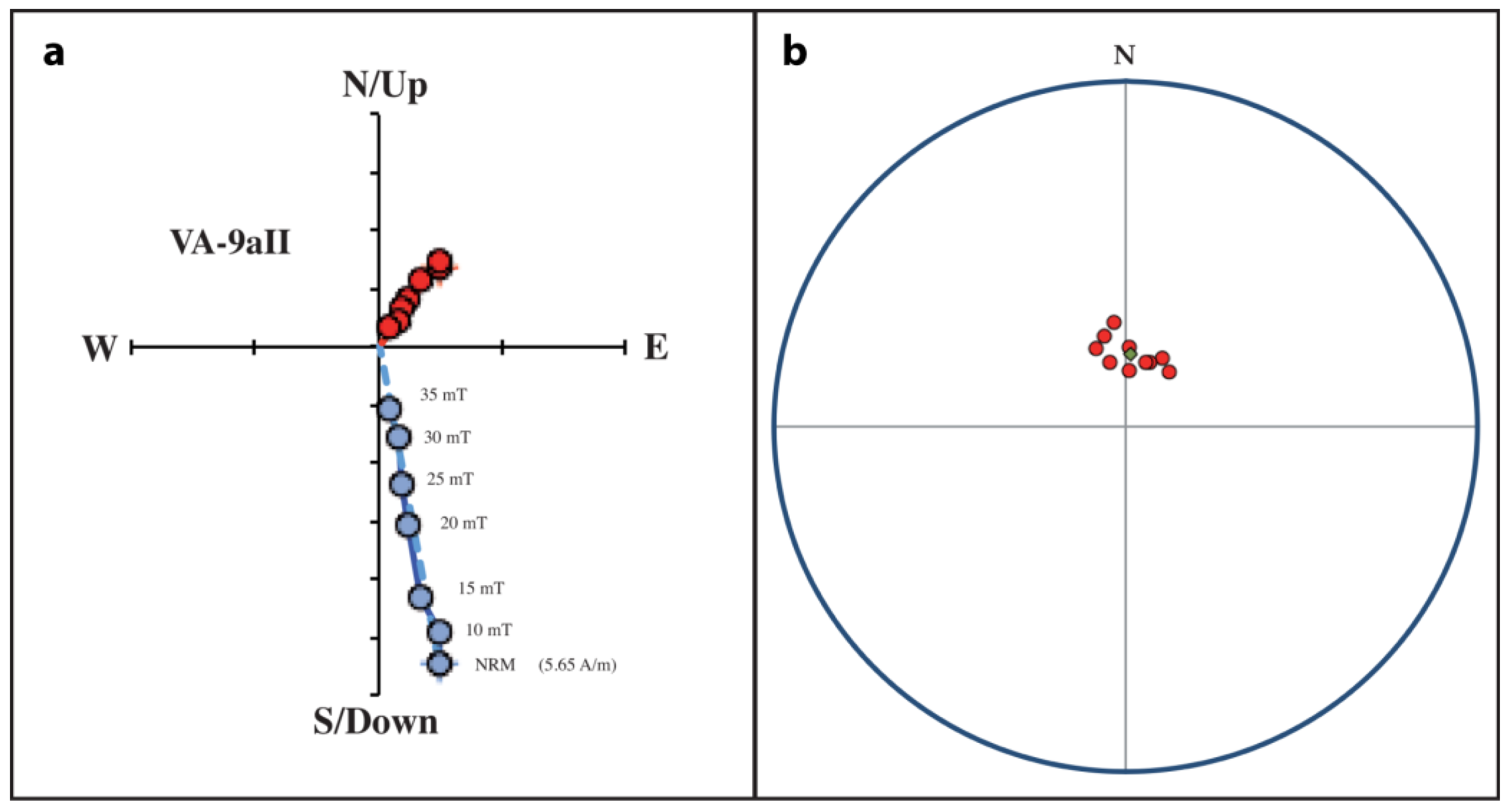
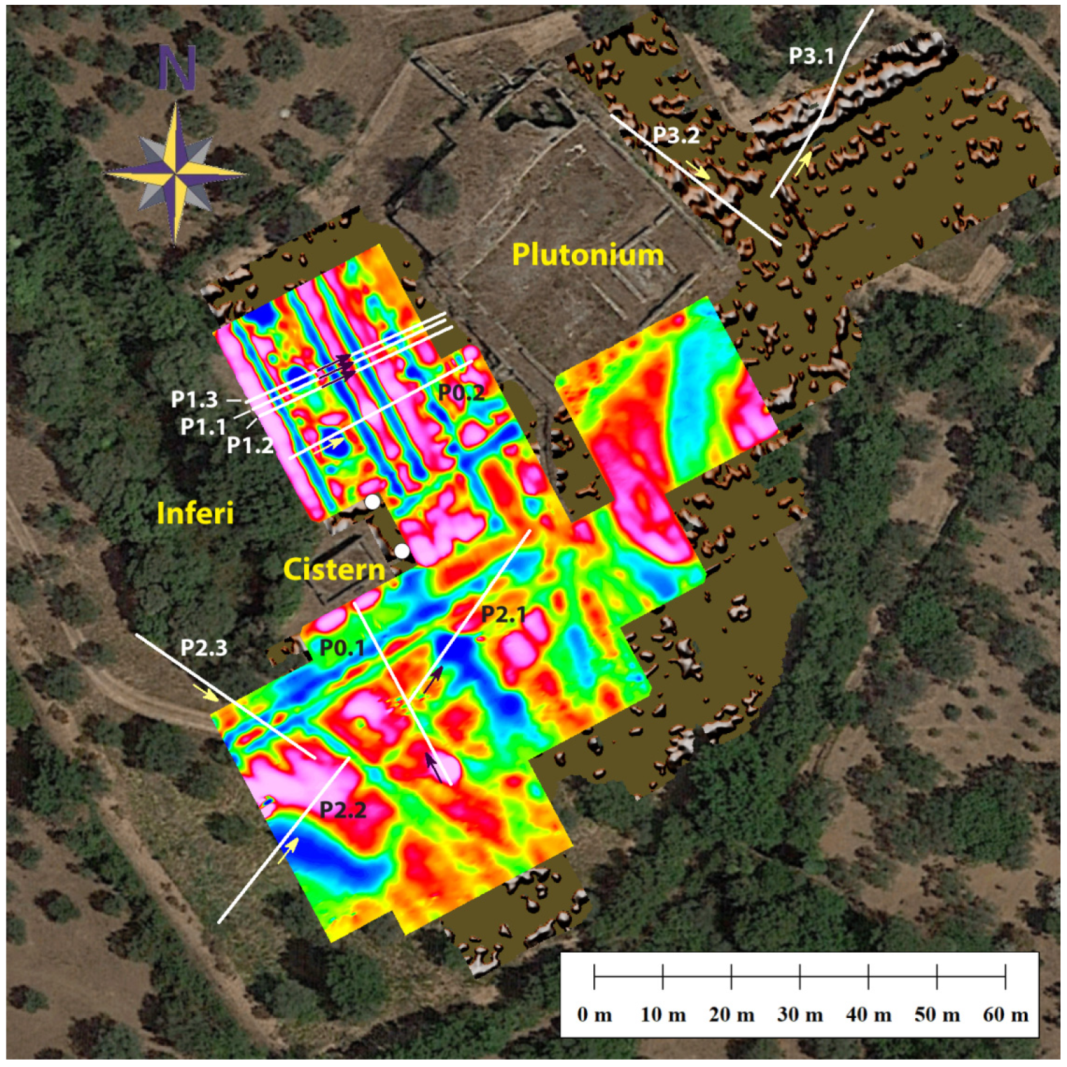
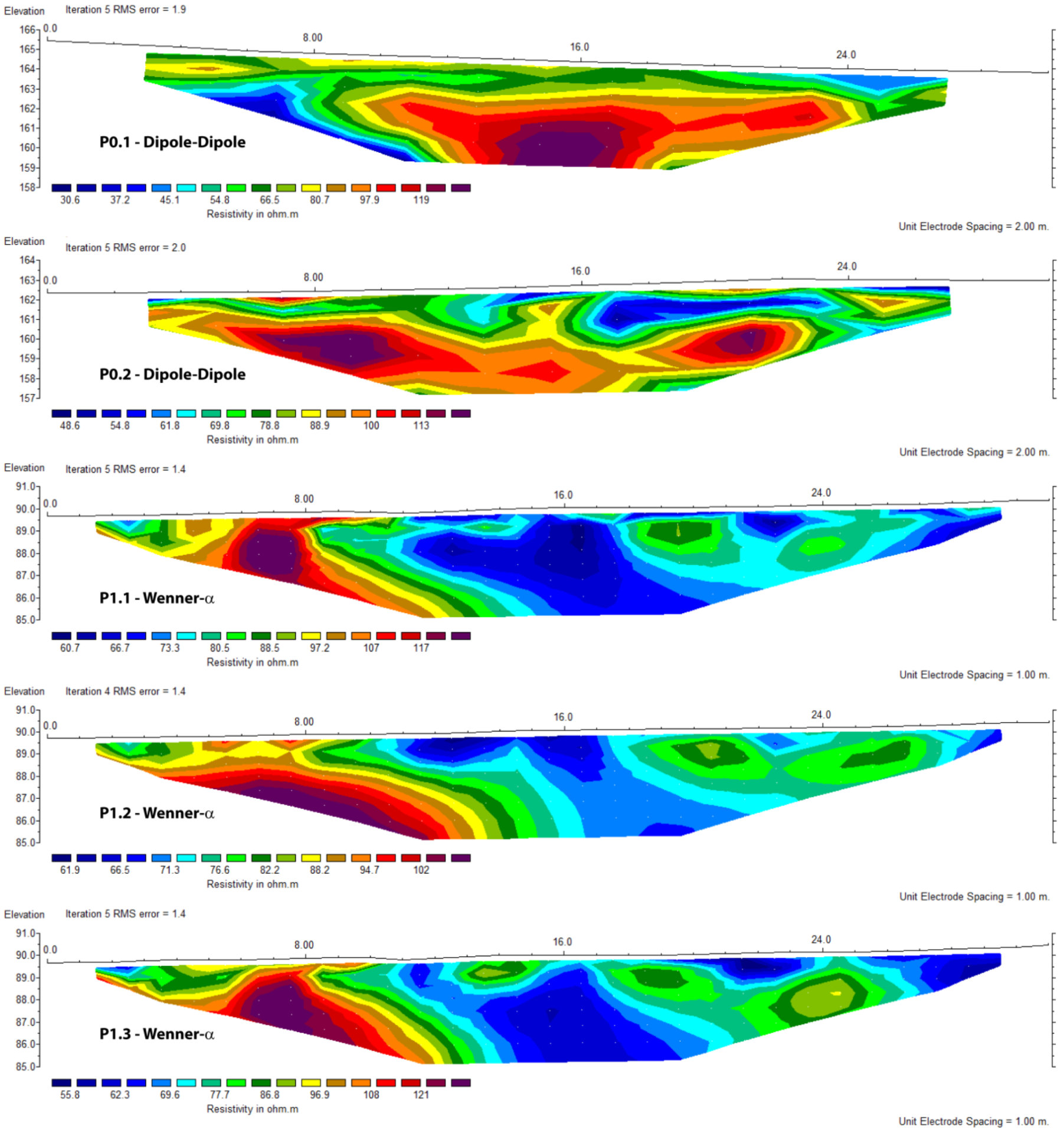
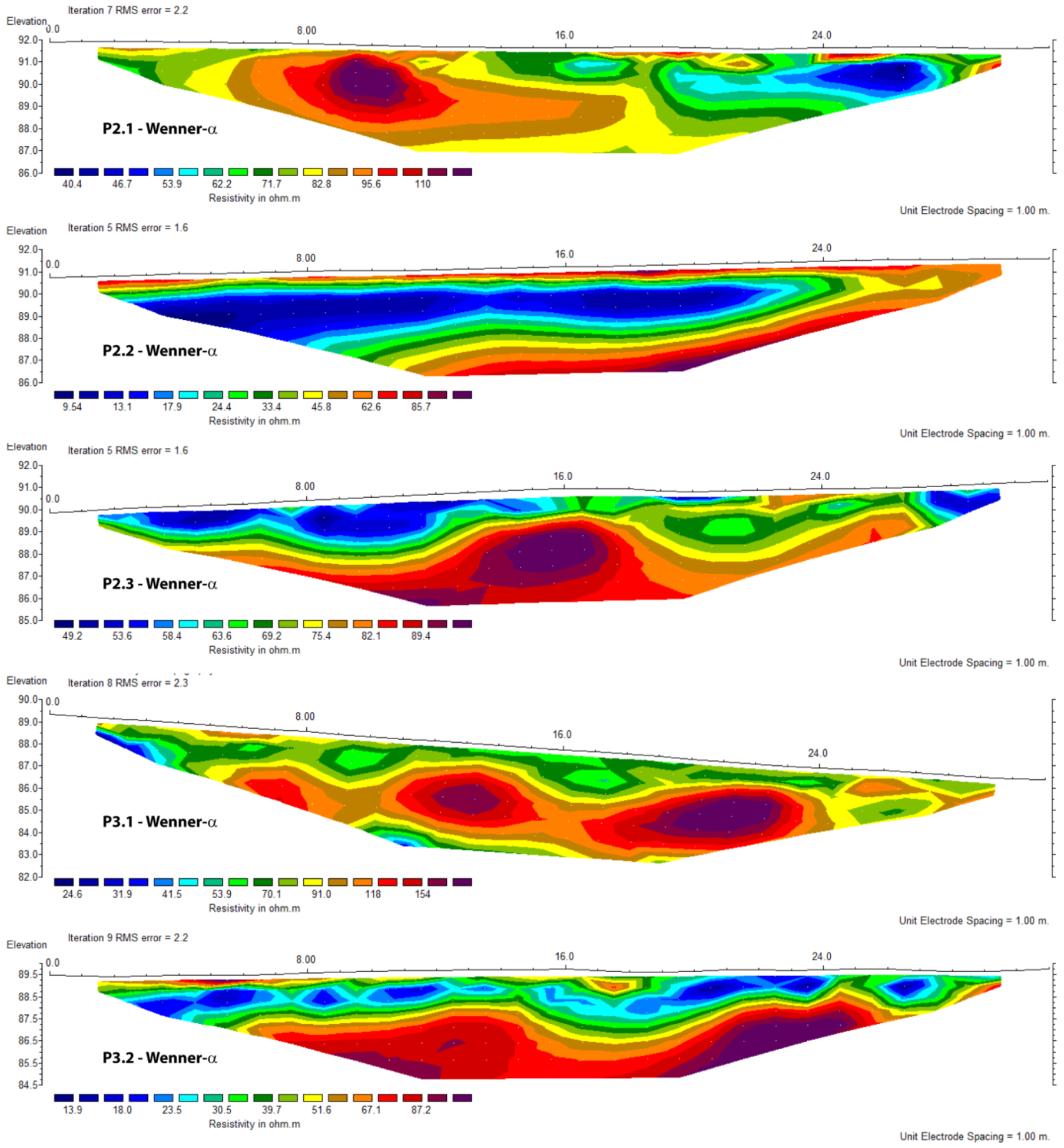
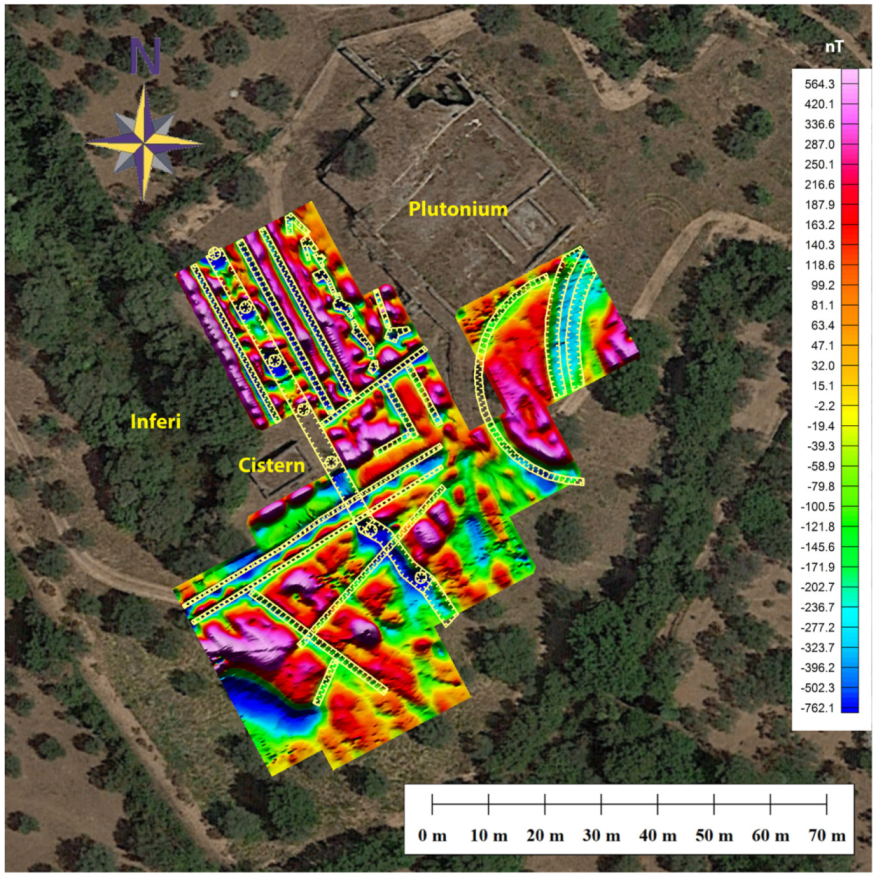
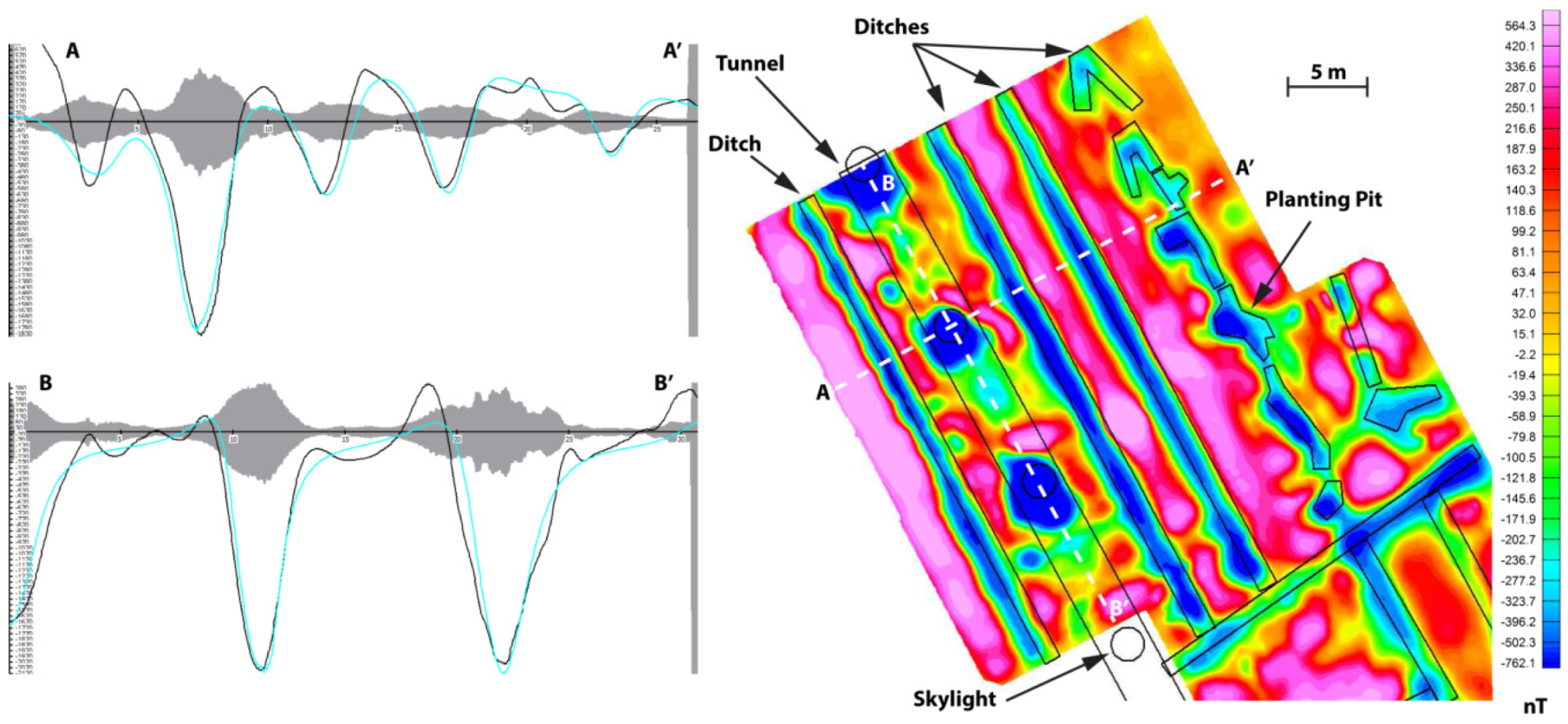
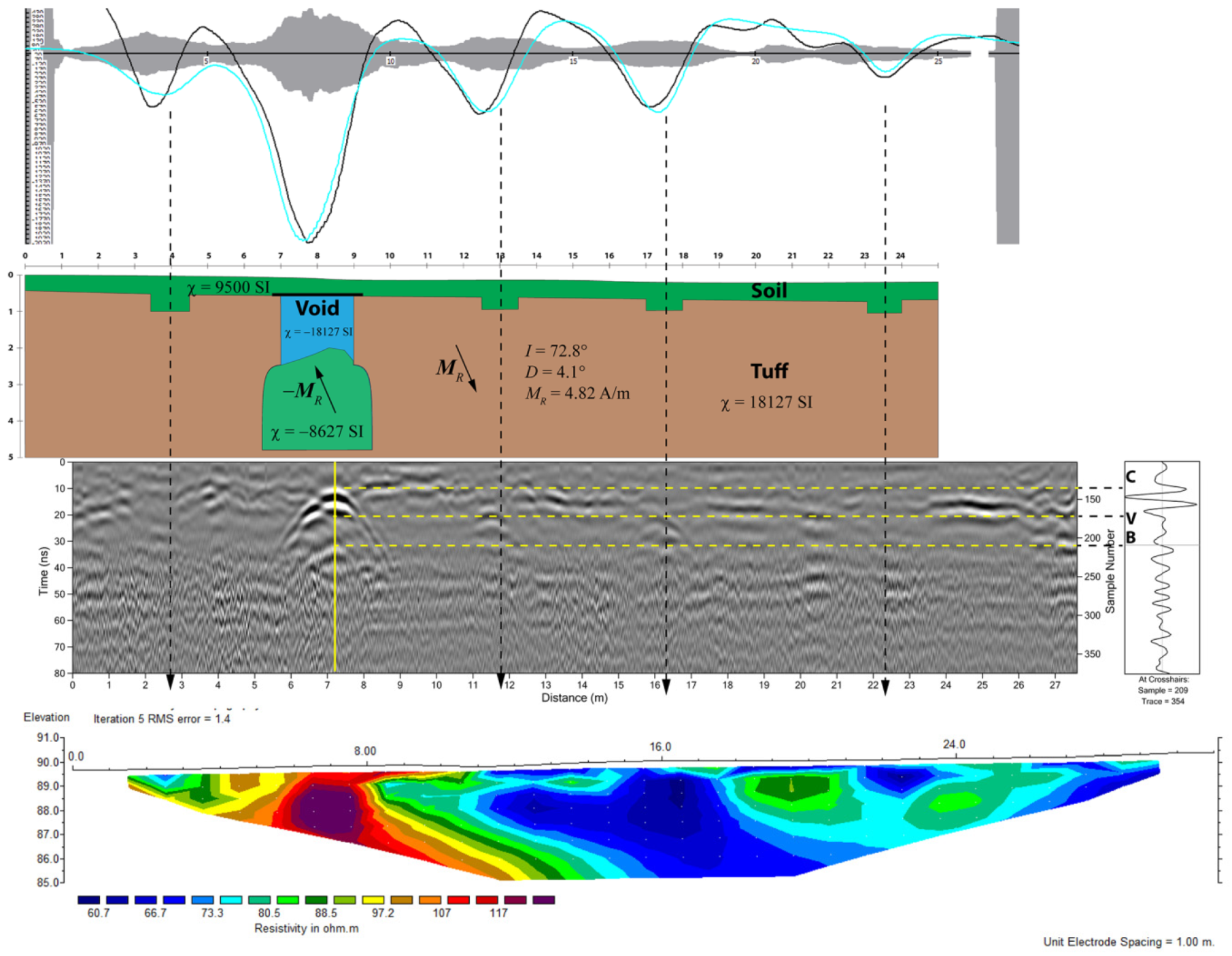

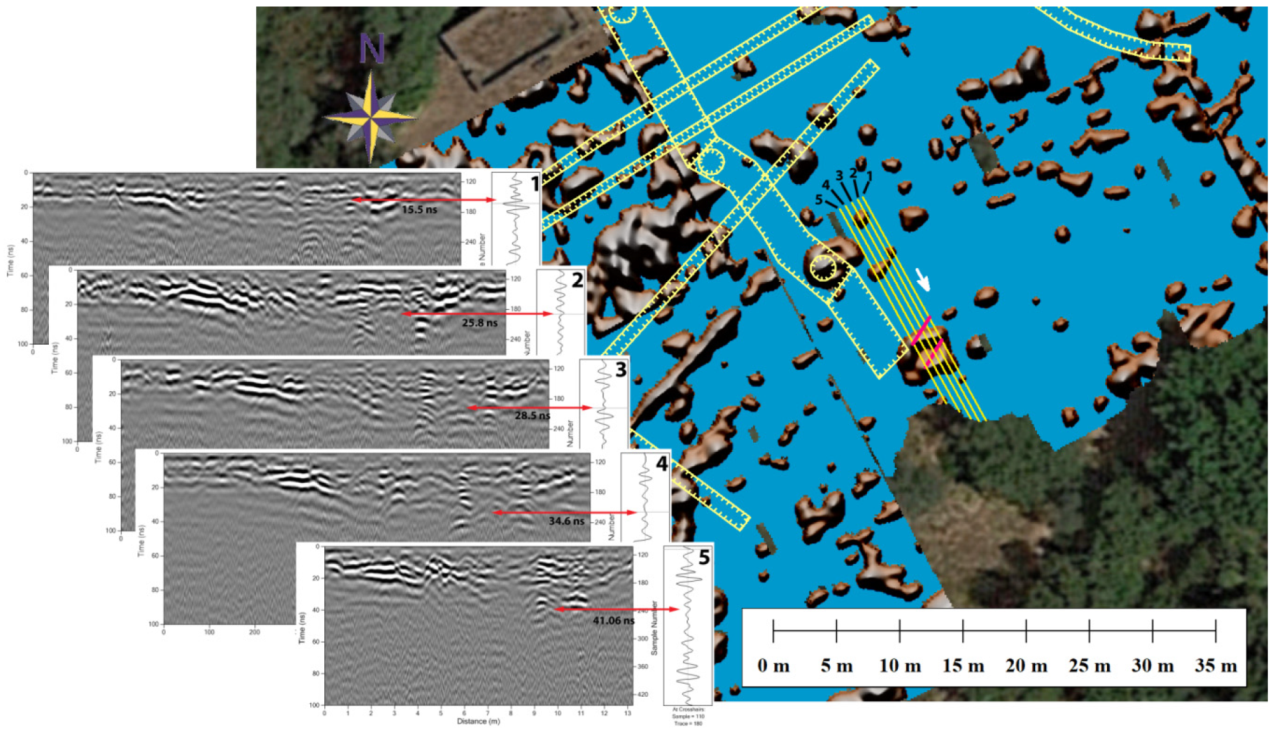
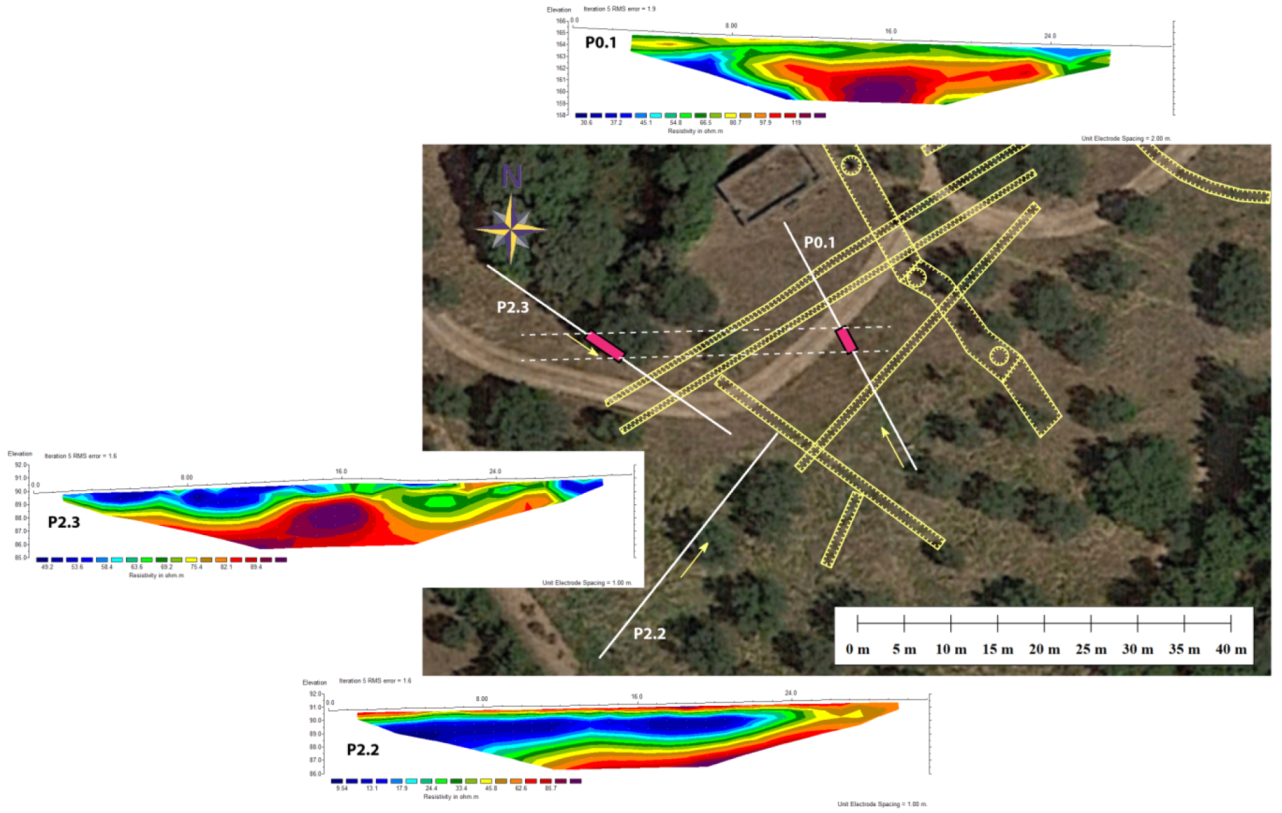
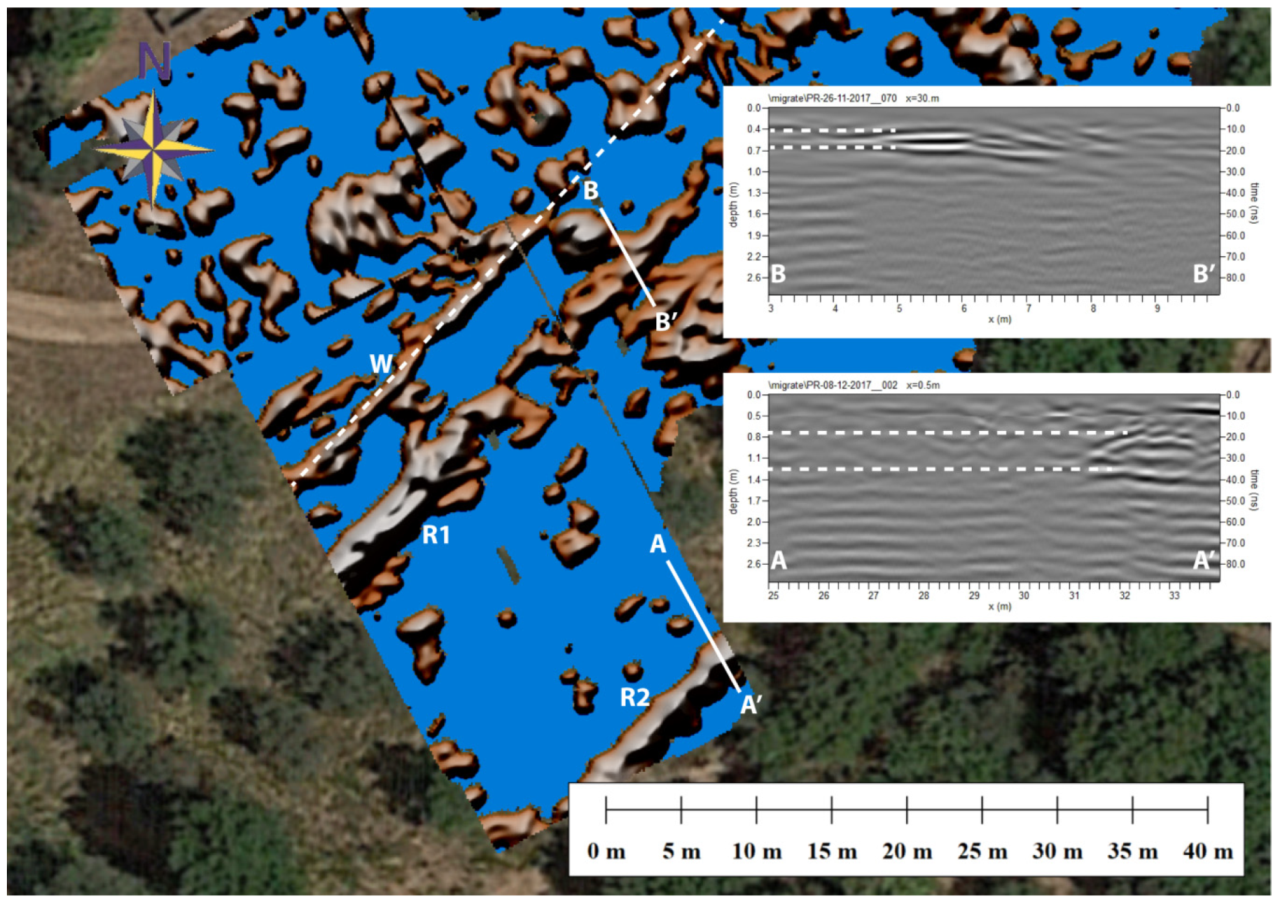

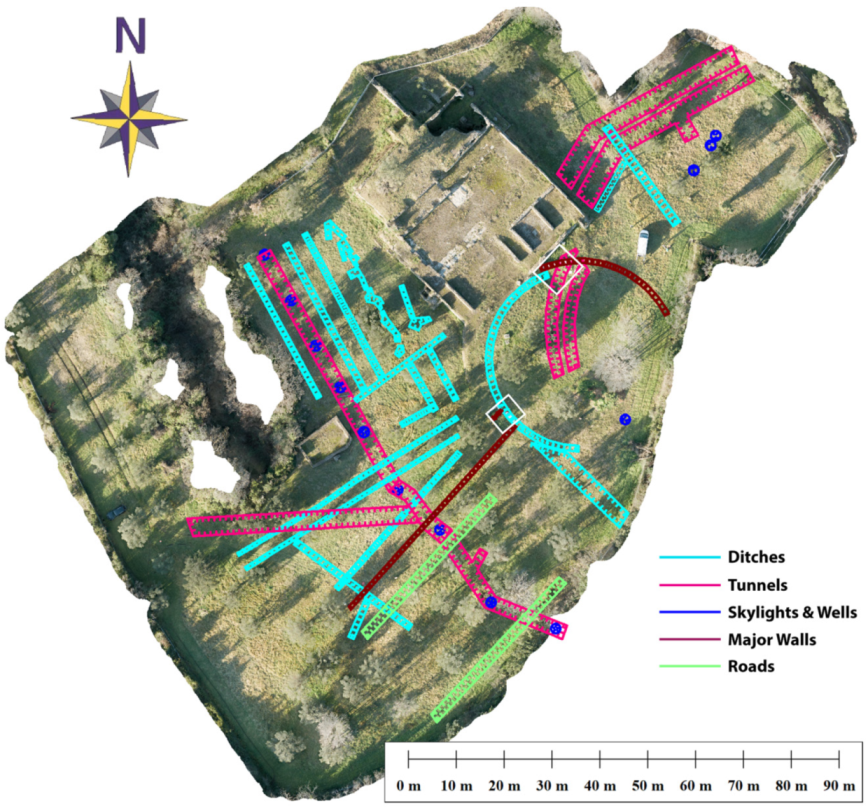
| Software | Author/Company | Usage |
|---|---|---|
| GPR Viewer 1.8.5 | J. E. Lucius & L. B. Conyers | Analysis of GPR profiles |
| GPR Slice v7 | Geophysical Archaeometry Laboratory | Basic processing of GPR data and generation of amplitude slices |
| Magmap 2000 v. 5.04 | Geometrics | Magnetic data pre-processing |
| Oasis Montaj 8.3 | Geosoft | Magnetic and GPR amplitude grid processing |
| Res2Dinv 3.54 | Geotomo Software | Electric resistivity inversion |
| Photoscan 1.4.5 | Agisoft | Aerial photogrammetry |
| Thopos 2018 | Studio Tecnico Guerra | Aerial photogrammetry |
| MatLab R2017 | MathWorks | Polynomial regression of magnetic field intensity data |
| ArchaeoMag 2.5 | A. Schettino & A. Ghezzi | Forward modelling of magnetic data |
| 01 | 02 | 03 | 04 | 05 | 06 | 07 | 08 | 09 | 10 | 11 | 12 | 13 | |
|---|---|---|---|---|---|---|---|---|---|---|---|---|---|
| <v> | 6.7 | 9.3 | 6.6 | 5.6 | 8.2 | 5.0 | 7.3 | 4.4 | 6.3 | 6.5 | 7.0 | 6.7 | 7.0 |
| <ε> | 20.1 | 10.5 | 20.7 | 28.5 | 13.4 | 35.7 | 17.1 | 45.8 | 22.4 | 21.5 | 18.3 | 19.8 | 18.4 |
| Sample Id. | DPCA [°deg] | IPCA [°deg] | MAD [°deg] | NRM [A m−1] | χ [×10−6] | Q |
|---|---|---|---|---|---|---|
| VA–4 | 346.72 | 74.31 | 0.88 | 4.58 | 18,820 | 6.98 |
| VA–5 | 2.63 | 71.10 | 1.06 | 4.71 | 19,170 | 7.05 |
| VA–6aI | 27.87 | 71.73 | 0.77 | 4.81 | 18,720 | 7.38 |
| VA–6aII | 38.54 | 73.77 | 0.98 | 5.05 | 18,850 | 7.68 |
| VA–7aI | 347.26 | 68.20 | 0.68 | 4.95 | 17,140 | 8.29 |
| VA–7aII | 353.76 | 65.32 | 0.48 | 5.30 | 19,410 | 7.83 |
| VA–7aIII | 19.76 | 73.96 | 0.62 | 4.84 | 18,360 | 7.56 |
| VA–8 | 339.25 | 70.30 | 1.29 | 5.00 | 18,250 | 7.86 |
| VA–9aII | 16.47 | 74.10 | 0.63 | 5.65 | 18,240 | 8.88 |
| VA–9aI | 2.97 | 76.88 | 1.10 | 4.24 | 14,980 | 8.12 |
| VA–1 | 4.07 | 14,800 | 7.90 | |||
| VA–2 | 5.04 | 22,290 | 6.49 | |||
| VA–3 | 29.59 | 70.48 | 4.42 | 16,620 | 7.63 |
| Feature | D [°deg] | I [°deg] | M [A m−1] | Δχ [×10−6] SI |
|---|---|---|---|---|
| Tuff layer | 4.1 | 72.8 | 4.82 | 0 |
| Soil layer | 0 | 0 | 0 | 0 |
| Air–filled cavities | 4.1 | 72.8 | −4.82 | −18127 |
| Soil–filled cavities | 4.1 | 72.8 | −4.82 | −8627 |
| Walls | 0 | 0 | 0 | −9500 |
| Roads | 0 | 0 | 0 | +5000 |
© 2019 by the authors. Licensee MDPI, Basel, Switzerland. This article is an open access article distributed under the terms and conditions of the Creative Commons Attribution (CC BY) license (http://creativecommons.org/licenses/by/4.0/).
Share and Cite
Ghezzi, A.; Schettino, A.; Pierantoni, P.P.; Conyers, L.; Tassi, L.; Vigliotti, L.; Schettino, E.; Melfi, M.; Gorrini, M.E.; Boila, P. Reconstruction of a Segment of the UNESCO World Heritage Hadrian’s Villa Tunnel Network by Integrated GPR, Magnetic–Paleomagnetic, and Electric Resistivity Prospections. Remote Sens. 2019, 11, 1739. https://doi.org/10.3390/rs11151739
Ghezzi A, Schettino A, Pierantoni PP, Conyers L, Tassi L, Vigliotti L, Schettino E, Melfi M, Gorrini ME, Boila P. Reconstruction of a Segment of the UNESCO World Heritage Hadrian’s Villa Tunnel Network by Integrated GPR, Magnetic–Paleomagnetic, and Electric Resistivity Prospections. Remote Sensing. 2019; 11(15):1739. https://doi.org/10.3390/rs11151739
Chicago/Turabian StyleGhezzi, Annalisa, Antonio Schettino, Pietro Paolo Pierantoni, Lawrence Conyers, Luca Tassi, Luigi Vigliotti, Erwin Schettino, Milena Melfi, Maria Elena Gorrini, and Paolo Boila. 2019. "Reconstruction of a Segment of the UNESCO World Heritage Hadrian’s Villa Tunnel Network by Integrated GPR, Magnetic–Paleomagnetic, and Electric Resistivity Prospections" Remote Sensing 11, no. 15: 1739. https://doi.org/10.3390/rs11151739
APA StyleGhezzi, A., Schettino, A., Pierantoni, P. P., Conyers, L., Tassi, L., Vigliotti, L., Schettino, E., Melfi, M., Gorrini, M. E., & Boila, P. (2019). Reconstruction of a Segment of the UNESCO World Heritage Hadrian’s Villa Tunnel Network by Integrated GPR, Magnetic–Paleomagnetic, and Electric Resistivity Prospections. Remote Sensing, 11(15), 1739. https://doi.org/10.3390/rs11151739




